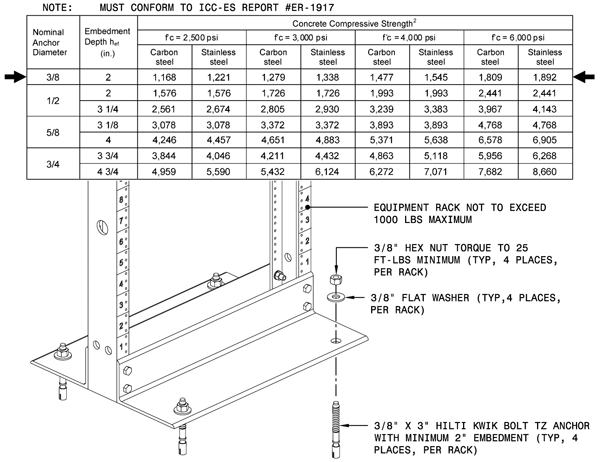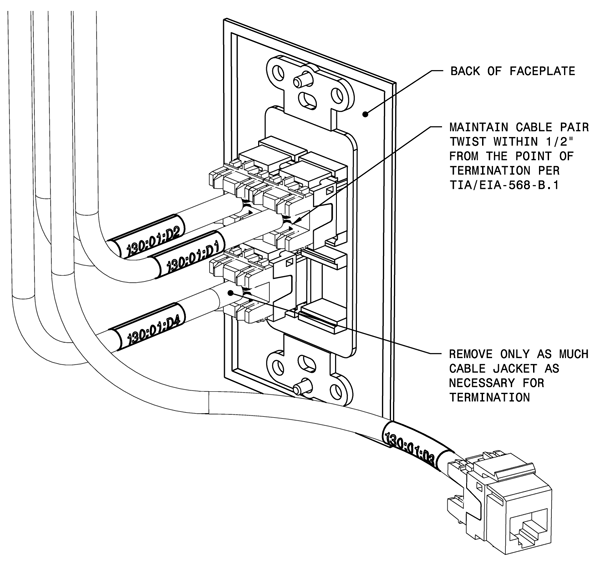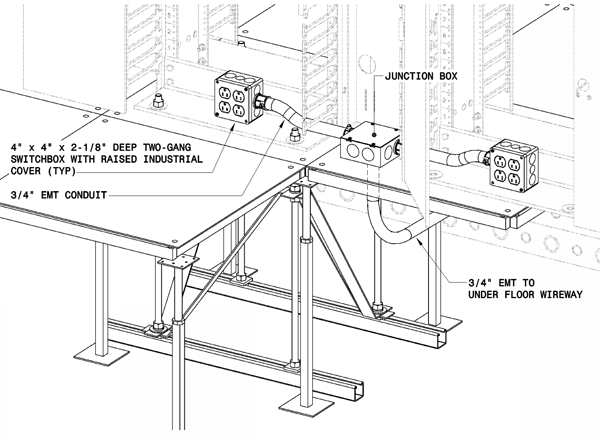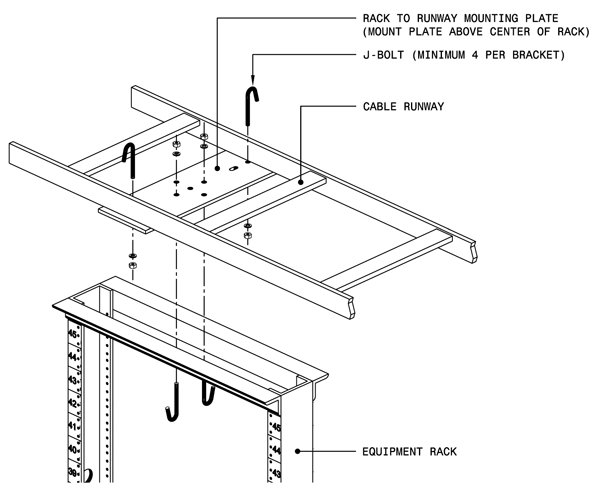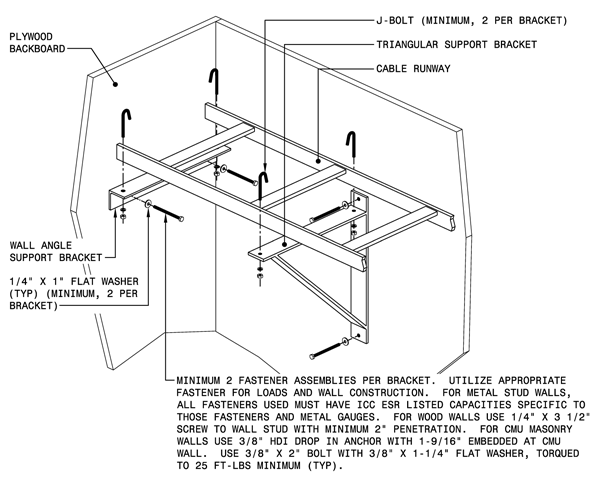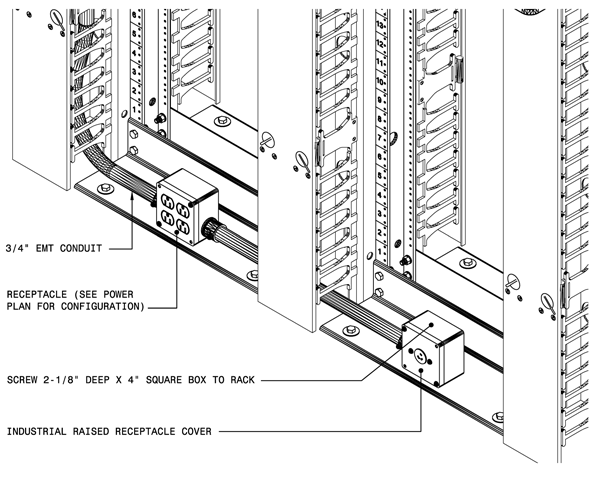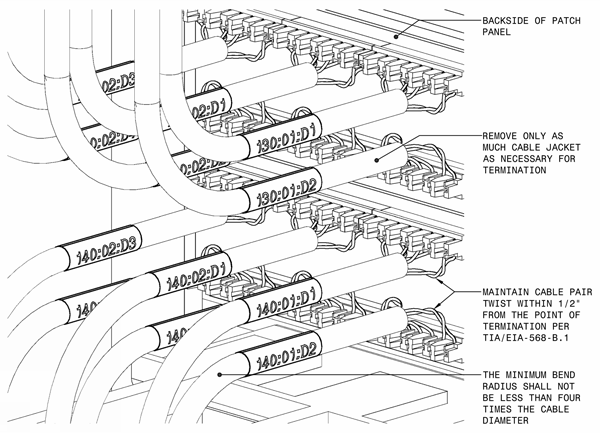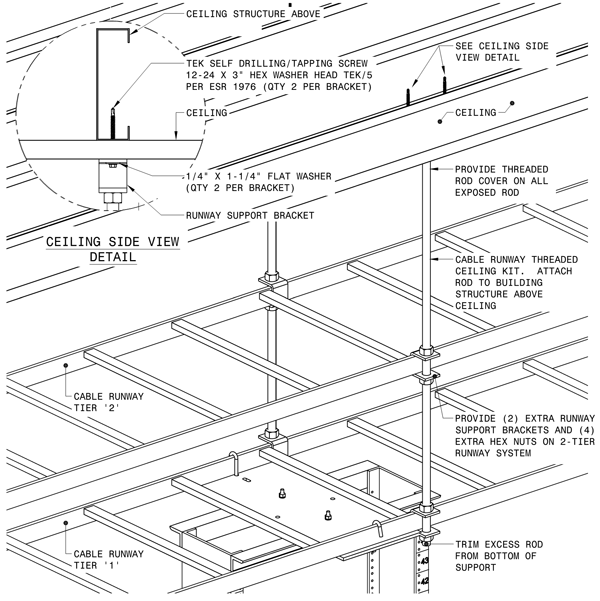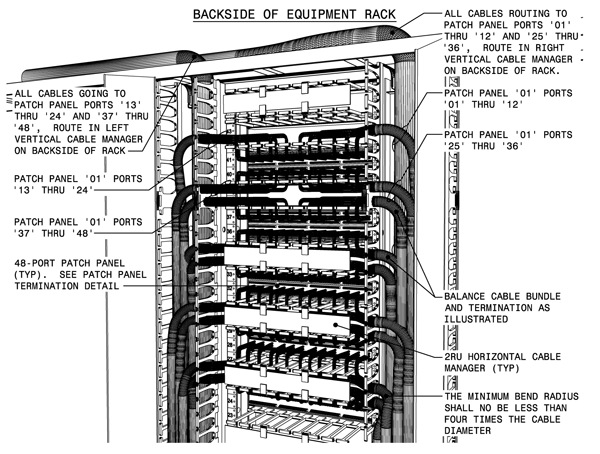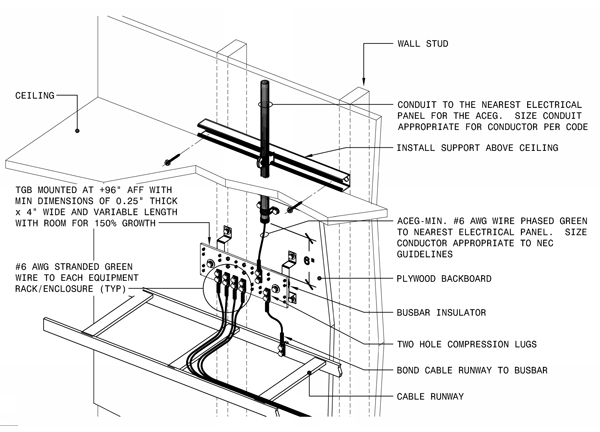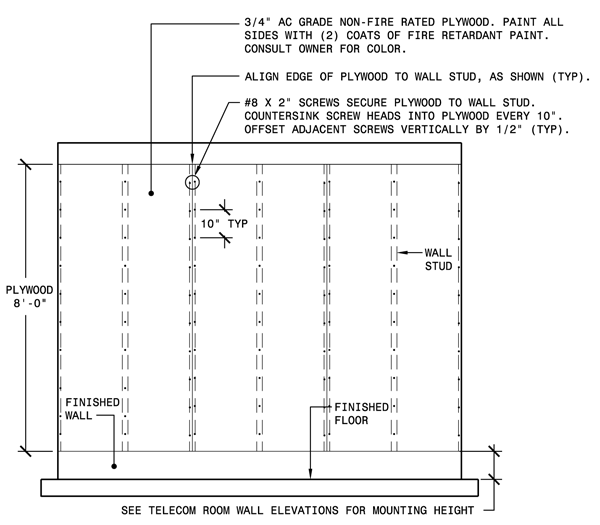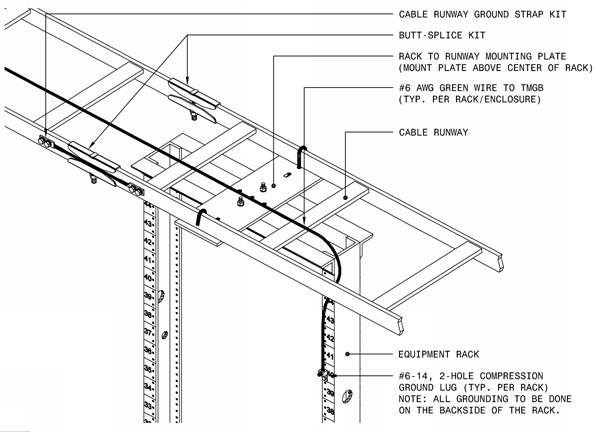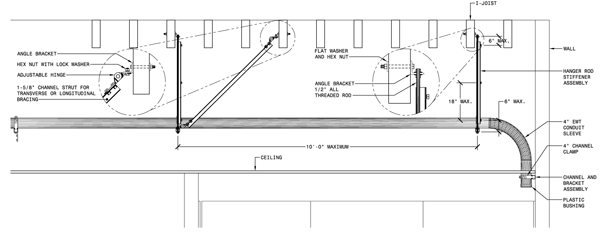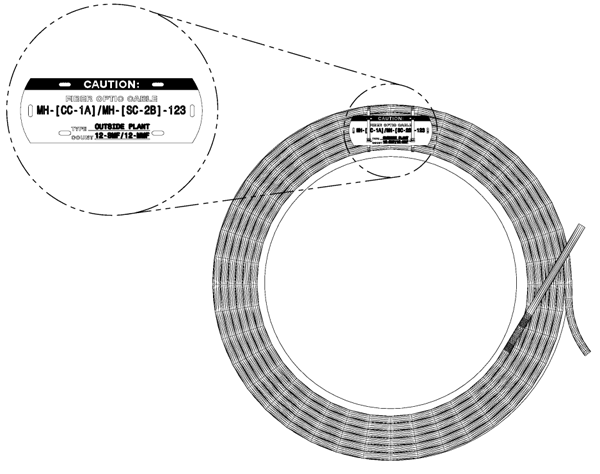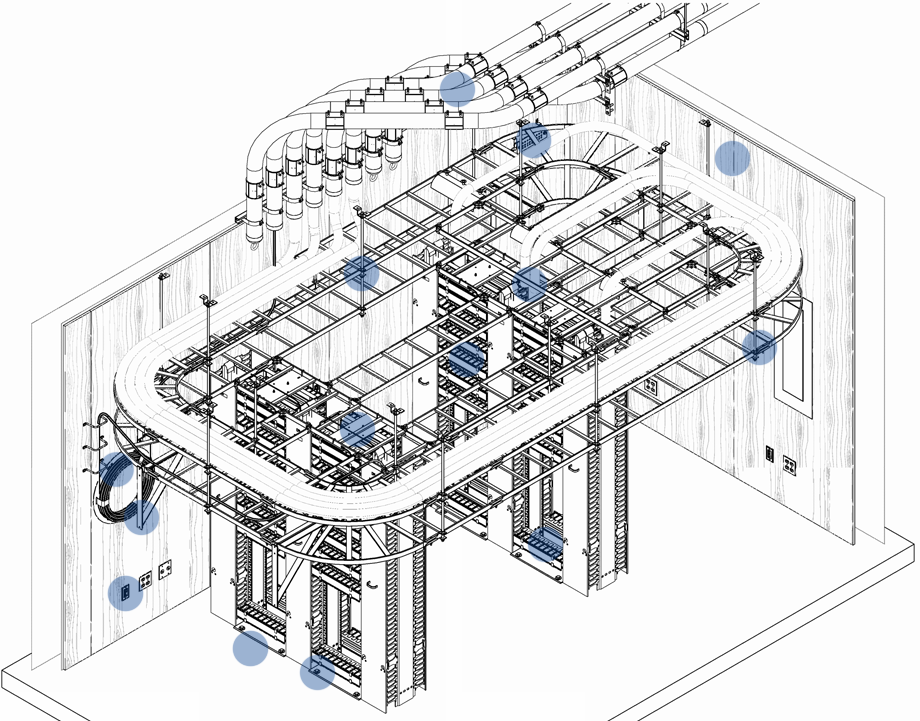
![]() ...are reviewed initially with each new Client; then adapted &
maintained continuously to ensure the Client and design team always
maintain the same technology vision.
...are reviewed initially with each new Client; then adapted &
maintained continuously to ensure the Client and design team always
maintain the same technology vision.
-
Technology Agnosticism
More!Technology Agnosticism
 The cabling infrastructure is not designed around any particular technology. Technologies
will come and go many times over the life of the cabling system. Therefore, no technology
in particular should be a design target.
The cabling infrastructure is not designed around any particular technology. Technologies
will come and go many times over the life of the cabling system. Therefore, no technology
in particular should be a design target.
-
Pathways & Spaces
Pathways & Spaces
 All cabling pathways and Telecom Rooms are designed to match the maximum capacity of
the spaces they serve and have adequate accessibility. All future cabling and technologies
can then be added without construction and with minimum business disruption.
All cabling pathways and Telecom Rooms are designed to match the maximum capacity of
the spaces they serve and have adequate accessibility. All future cabling and technologies
can then be added without construction and with minimum business disruption.
-
Ensure Sustainability
Ensure Sustainability
 No matter how superior a systems capabilities are, it won’t be used if the users don’t trust it
and/or the staff cannot operate and administer it effectively. All designs shall provide
maximum capabilities that are supportable and sustainable from the viewpoint of the Owner.
No matter how superior a systems capabilities are, it won’t be used if the users don’t trust it
and/or the staff cannot operate and administer it effectively. All designs shall provide
maximum capabilities that are supportable and sustainable from the viewpoint of the Owner.
-
Provide Telco Level Planning
Provide Telco Level Planning
 User expectations of a home telephone service are extremely high.
This reliability expection is the result of pre-planning, service, and implementation
rigor initially designed in by the
Telco design engineers. The Telco service technicians are simply propagating the model and
updating the documentation. This preplanning model clearly works and is a model every
enterprise network should be based on.
User expectations of a home telephone service are extremely high.
This reliability expection is the result of pre-planning, service, and implementation
rigor initially designed in by the
Telco design engineers. The Telco service technicians are simply propagating the model and
updating the documentation. This preplanning model clearly works and is a model every
enterprise network should be based on.
-
Certifiable Performance
Certifiable Performance
 Every cable, copper or optical fiber, is subject to a strict suite of performance criteria that
allows for calculable performance and technology support determinism. It is absolutely
determinable whether any particular future technology will work or not before you purchase.
Every cable, copper or optical fiber, is subject to a strict suite of performance criteria that
allows for calculable performance and technology support determinism. It is absolutely
determinable whether any particular future technology will work or not before you purchase.
-
Commonality of Infrastructure
Commonality of Infrastructure
 A properly designed uniform structured cabling system is easier to understand, test, and
maintain by your IT and maintenance staff than several disparate technologies.
A properly designed uniform structured cabling system is easier to understand, test, and
maintain by your IT and maintenance staff than several disparate technologies.
-
Convergence Is The Future
Convergence Is The Future
 The design and integration of the network electronics must take place before the turn-up of
converged systems requiring network transport. Networks are no longer just an overlay
system and relatively insignificant.
The design and integration of the network electronics must take place before the turn-up of
converged systems requiring network transport. Networks are no longer just an overlay
system and relatively insignificant.
-
Manufacturer's Warranties
Manufacturer's Warranties
 When designed and certified strictly per TIA standards, cabling systems typically carry a
manufacturer’s warranty of 25 years or greater on both cabling and installation.
When designed and certified strictly per TIA standards, cabling systems typically carry a
manufacturer’s warranty of 25 years or greater on both cabling and installation.
-
Manufacturer Agnosticism
Manufacturer Agnosticism
 Proprietary cabling systems are be avoided. Proprietary products are typically pre-standard
versions and may never reach the performance criteria of the next ratified standard.
Staying standardized means you’ll never be subject to vendor lock-in.
Proprietary cabling systems are be avoided. Proprietary products are typically pre-standard
versions and may never reach the performance criteria of the next ratified standard.
Staying standardized means you’ll never be subject to vendor lock-in.
-
Industry Standards Adherence
Industry Standards Adherent Designs
 Maintaining that your buildings use a TIA Standards based infrastructure ensures that the
technology manufacturers are always designing their products to work with your installed
infrastructure and not the reverse.
Maintaining that your buildings use a TIA Standards based infrastructure ensures that the
technology manufacturers are always designing their products to work with your installed
infrastructure and not the reverse.
-
Coverged Infrastructures
Coverged Infrastructures
 By converging building systems over a common infrastructure from the initial design, funds
typically allocated for non-converged conventional systems (intra-building and inter-building
parallel conduit, cabling, and termination labor) may be reallocated to build a more robust
internetwork from the original construction budget.
By converging building systems over a common infrastructure from the initial design, funds
typically allocated for non-converged conventional systems (intra-building and inter-building
parallel conduit, cabling, and termination labor) may be reallocated to build a more robust
internetwork from the original construction budget.
-
Centralized Head-End Equipment
Centralized Head-End Equipment
 Similar to the way it’s unnecessary to know where Google is located, converged services
may be hosted/sourced from any well contacted location in or beyond your network. This
improves IT response and repair times by putting the equipment wherever the IT staff that
maintains them reside (even if it’s outsourced).
Similar to the way it’s unnecessary to know where Google is located, converged services
may be hosted/sourced from any well contacted location in or beyond your network. This
improves IT response and repair times by putting the equipment wherever the IT staff that
maintains them reside (even if it’s outsourced).
-
Collapsed Core
Collapsed Core
 A collapsed core allows you to save money by leveraging economies of scale and more
completely utilizing the head-end hardware. The savings results from the ability to allow
multiple remote sites to share fewer, but more robust, head-end hardware as opposed to
distributed less robust, under-utilized, hardware units at each site.
A collapsed core allows you to save money by leveraging economies of scale and more
completely utilizing the head-end hardware. The savings results from the ability to allow
multiple remote sites to share fewer, but more robust, head-end hardware as opposed to
distributed less robust, under-utilized, hardware units at each site.
-
Transport Supervision
Transport Supervision
 By using the network as the common transport for all building systems, a single well
understood management system could monitor the transport for all systems.
By using the network as the common transport for all building systems, a single well
understood management system could monitor the transport for all systems.
-
Rigorous Drawing Detail
Rigorous Drawing Detail
 Drawings must have sufficient detail to allow you to legally, and confidently, enforce both
the quantitative and qualitative design requirements. The detail should allow for “legally
binding determinism” regardless of the Contractor chosen.
Drawings must have sufficient detail to allow you to legally, and confidently, enforce both
the quantitative and qualitative design requirements. The detail should allow for “legally
binding determinism” regardless of the Contractor chosen.
-
Onsite & Offsite Administration
Onsite & Offsite Administration
 All facets of the design and implementation shall as thorough, standards based, and
self-documenting as possible to allow for easy port/device differentiation from both
onsite and offsite; with docs or without. Electronics administration should be possible
from anywhere with IP connectivity.
All facets of the design and implementation shall as thorough, standards based, and
self-documenting as possible to allow for easy port/device differentiation from both
onsite and offsite; with docs or without. Electronics administration should be possible
from anywhere with IP connectivity.
-
Make an Explicit Technology Baseline
Make an Explicit Technology Baseline
 The design and final documentation educates your current and future IT staff and provides
an explicit and thoughtful technology baseline to continue from with future projects.
The design and final documentation educates your current and future IT staff and provides
an explicit and thoughtful technology baseline to continue from with future projects.
-
Provide Continuing ROI
Provide Continuing ROI
 The Design & documentation shall be sufficient for IT administrators to easily and explicitly
delegate tasks remotely to junior staff through WYSIWYG drawings. Saving IT staff
time while facilitating the maintenance of the as-built documentation which saves
future design fees and construction surprises.
The Design & documentation shall be sufficient for IT administrators to easily and explicitly
delegate tasks remotely to junior staff through WYSIWYG drawings. Saving IT staff
time while facilitating the maintenance of the as-built documentation which saves
future design fees and construction surprises.
